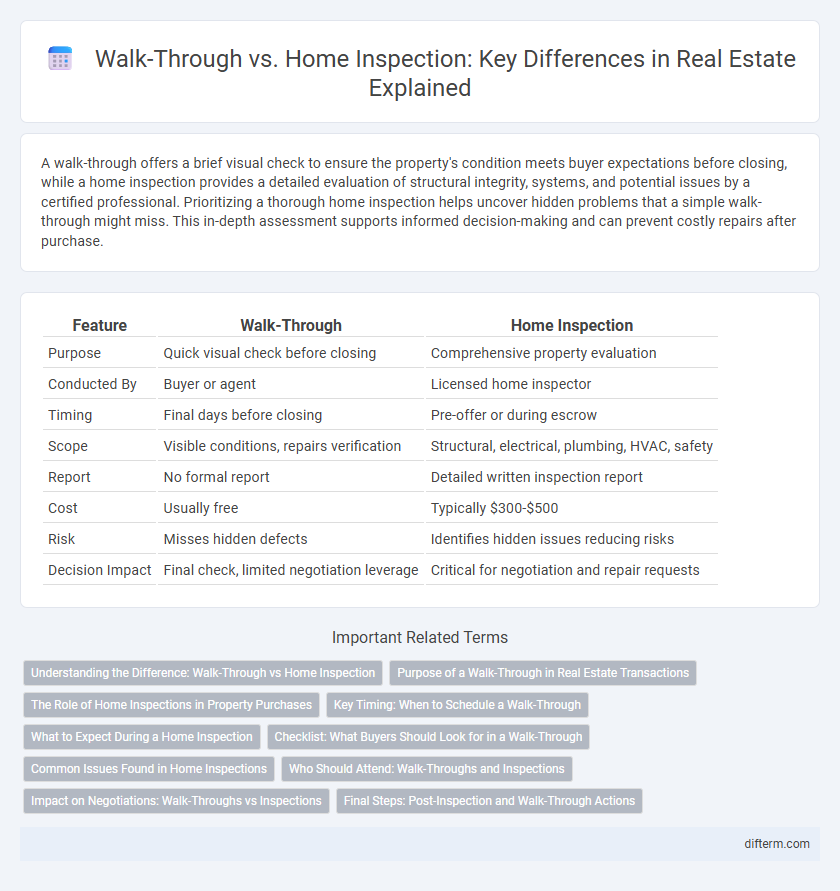A walk-through offers a brief visual check to ensure the property's condition meets buyer expectations before closing, while a home inspection provides a detailed evaluation of structural integrity, systems, and potential issues by a certified professional. Prioritizing a thorough home inspection helps uncover hidden problems that a simple walk-through might miss. This in-depth assessment supports informed decision-making and can prevent costly repairs after purchase.
Table of Comparison
| Feature | Walk-Through | Home Inspection |
|---|---|---|
| Purpose | Quick visual check before closing | Comprehensive property evaluation |
| Conducted By | Buyer or agent | Licensed home inspector |
| Timing | Final days before closing | Pre-offer or during escrow |
| Scope | Visible conditions, repairs verification | Structural, electrical, plumbing, HVAC, safety |
| Report | No formal report | Detailed written inspection report |
| Cost | Usually free | Typically $300-$500 |
| Risk | Misses hidden defects | Identifies hidden issues reducing risks |
| Decision Impact | Final check, limited negotiation leverage | Critical for negotiation and repair requests |
Understanding the Difference: Walk-Through vs Home Inspection
A walk-through is a final visual review conducted by the buyer to ensure the property's condition matches the agreed terms before closing, focusing on surface-level issues and overall cleanliness. A home inspection is a detailed, professional evaluation that examines structural elements, systems, and potential safety hazards, providing an in-depth report for informed purchasing decisions. Understanding the difference between a walk-through and a home inspection is crucial for buyers to protect their investment and avoid unexpected repair costs.
Purpose of a Walk-Through in Real Estate Transactions
A walk-through in real estate transactions serves as a final check by the buyer to ensure the property's condition matches the agreed contract terms before closing. Its primary purpose is to verify repairs have been completed, fixtures remain intact, and there are no new damages or issues. This step helps prevent last-minute surprises and confirms the home is move-in ready.
The Role of Home Inspections in Property Purchases
Home inspections play a crucial role in property purchases by providing a detailed evaluation of a home's condition, identifying potential issues such as structural defects, electrical problems, or HVAC system malfunctions. Unlike walk-throughs, which are brief visual assessments typically conducted before closing, home inspections involve a licensed inspector thoroughly examining the property to uncover hidden defects and estimate repair costs. This detailed inspection helps buyers make informed decisions, negotiate repairs or price adjustments, and avoid costly surprises after the purchase.
Key Timing: When to Schedule a Walk-Through
Schedule a final walk-through within 24 hours before closing to verify the property's condition and ensure all agreed-upon repairs are completed. This step helps confirm no new damage occurred since the home inspection and verifies that the seller has vacated the premises. Timing is critical to address last-minute issues before ownership transfer, protecting the buyer's investment.
What to Expect During a Home Inspection
During a home inspection, a certified inspector thoroughly examines the property's structural components, including the foundation, roof, plumbing, electrical systems, and HVAC. Expect detailed reporting on potential issues such as water damage, mold, or faulty wiring, helping buyers make informed decisions. Unlike a walk-through, which is a final visual check, the home inspection provides an in-depth analysis of the home's condition and safety.
Checklist: What Buyers Should Look for in a Walk-Through
During a walk-through, buyers should meticulously check for cosmetic damages, ensuring walls, floors, and ceilings are free from cracks, stains, or holes, and verify that doors and windows open and close properly. Essential systems such as plumbing, electrical outlets, heating, and cooling units need to be tested for functionality, while appliances included in the sale should be operational and undamaged. Buyers must confirm that any agreed-upon repairs have been completed and that the property is in move-in condition, using a comprehensive checklist to systematically document any discrepancies before closing.
Common Issues Found in Home Inspections
Home inspections commonly reveal issues such as structural damage, electrical system faults, plumbing leaks, and HVAC malfunctions that are often overlooked during a simple walk-through. Walk-throughs primarily focus on visible, surface-level conditions and aesthetics, missing critical problems like mold, foundation cracks, or faulty wiring detected during a professional inspection. Identifying these common issues in home inspections helps buyers make informed decisions and negotiate repairs or price adjustments.
Who Should Attend: Walk-Throughs and Inspections
Buyers, sellers, and real estate agents should attend both walk-throughs and home inspections to ensure transparency and address any concerns before closing. Walk-throughs allow buyers to verify the property's condition and confirm requested repairs, while home inspections require a licensed inspector to identify structural or safety issues. Builders and contractors may also join inspections to assess necessary fixes or improvements.
Impact on Negotiations: Walk-Throughs vs Inspections
Walk-throughs provide a final visual check for obvious defects, impacting negotiations minimally since they occur after contracts are signed. Home inspections offer a thorough analysis of structural, electrical, and plumbing systems, often uncovering issues that significantly influence repair credits or price adjustments during negotiations. The timing and depth of inspections give buyers leverage to renegotiate terms, while walk-throughs mainly confirm the property's condition before closing.
Final Steps: Post-Inspection and Walk-Through Actions
After a home inspection, document and address any identified repairs or safety concerns with the seller promptly to negotiate necessary fixes or credits. During the final walk-through, verify that agreed-upon repairs have been completed and ensure the property's condition matches the contract terms before closing. Both steps are crucial for mitigating risks and confirming the property's readiness for transfer ownership.
Walk-Through vs Home Inspection Infographic

 difterm.com
difterm.com